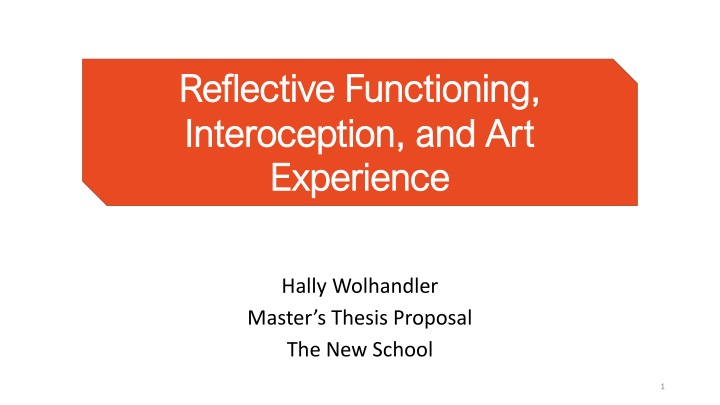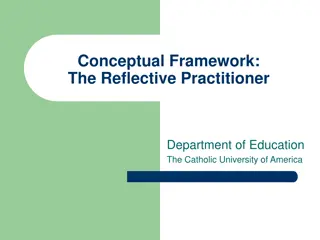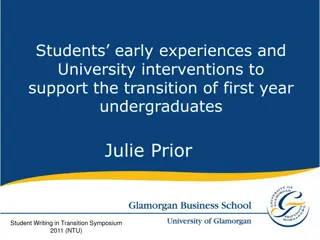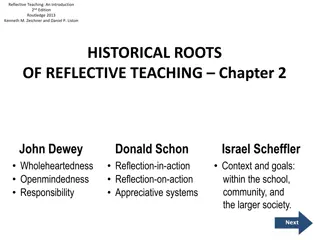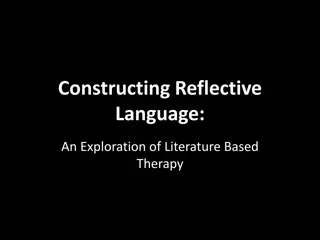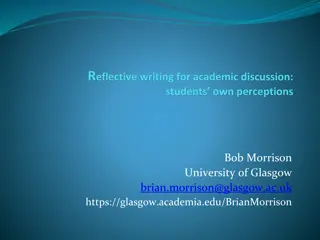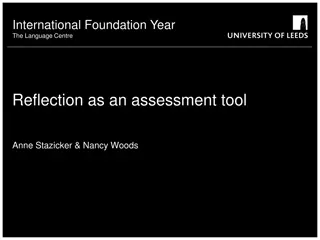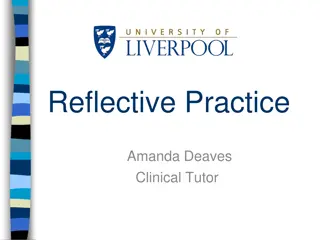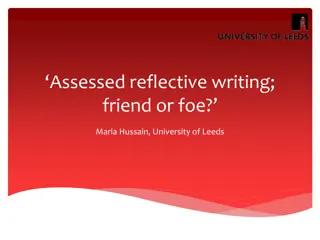Exploring the Relationship Between Reflective Functioning, Interoception, and Art Experience in Undergraduates
This study proposal aims to investigate the correlations between Reflective Functioning (RF), interoception, and art experience among undergraduates. Through exploring how RF and interoception are linked to affect regulation, emotion, and the sense of self, the study seeks to shed light on the role of the body in attachment and narrative representation.
Download Presentation

Please find below an Image/Link to download the presentation.
The content on the website is provided AS IS for your information and personal use only. It may not be sold, licensed, or shared on other websites without obtaining consent from the author.If you encounter any issues during the download, it is possible that the publisher has removed the file from their server.
You are allowed to download the files provided on this website for personal or commercial use, subject to the condition that they are used lawfully. All files are the property of their respective owners.
The content on the website is provided AS IS for your information and personal use only. It may not be sold, licensed, or shared on other websites without obtaining consent from the author.
E N D
Presentation Transcript
Reflective Functioning, Reflective Functioning, Interoception, and Art Interoception, and Art Experience Experience Hally Wolhandler Master s Thesis Proposal The New School 1
Study Proposal: Abstract Are there correlations between RF, interoception, and art experience in undergraduates? No studies yet linking interoception and RF (or interoception and attachment) RF and interoception inextricably tied to affect regulation, emotion, and sense of self RF and interoception theorized to be transmitted through early caregiving Elucidate role of the body in attachment Link body processes to narrative representation
What is Interoception? Interoception is the perception of internal bodily cues (Cameron, 2001) Interoception is a bottom-up and top-down process (Wiens, 2005) Interoception Proprioception Exteroception Embodiment 3
Measuring Interoception Interoception Interoceptive Accuracy (IAcc): Empirically measured interoceptive awareness (Garfinkel et al., 2015) Interoceptive Accuracy (IAcc) Interoceptive Awareness IAcc commonly measured with a heartbeat perception task (Schandry, 1981) 4
Interoception and Emotion James-Lange Theory of Emotion: Emotions originate in bodily functions (James & Lang, 1922) Somatic Marker Hypothesis (Damasio, 1996) The same brain structures (right AIC and ACC) are involved in interoception and emotional awareness The insula integrates bodily and environmental information to present the embodied self to the brain; inextricably linked to feeling states (Craig, 2009) Bodily signals lay the groundwork for embodiment and sense of self, selfhood (Tsakiris, 2017) 5
Interoceptive Accuracy and Feeling States Higher IAcc linked to: Better emotion regulation strategies (Kever, Pollatos, Vermeulen, & Grynberg, 2015) Greater intensity of emotions (Pollatos, Gramann, Schandry, 2007) Greater empathy (Grynberg & Pollatos, 2015) and being more sensitive to the emotions of others (Terasawa, Moriguchi, Tochizawa, Umeda, 2014) Trait anxiety (Pollatos, Traut-Mattausch, Schroeder, Schandry, 2007) Low Iacc Among those with ASD (Garfinkel et al., 2016) and alexithymia (Shah, Hall, Catmur, & Bird, 2016) Depressive symptoms (Pollatos, Traut-Mattausch, Schandry, 2009) 6
Interoceptive Accuracy and the Body/Arts Lower IAcc linked to eating disorders particularly AN (Pollatos et al., 2008) Higher IAcc linked to stronger sense of bodily ownership (Suzuki et al., 2013) People involved in the arts may have higher IAcc Musicians (Schirmer-Mokwa et al., 2015) Dancers (Christensen, Gaigg, Calvo-Merino, 2017) Art involves eliciting an emotional experience and expressing it through the body; monitoring this process improves IAcc Artists and AAI: More trauma/loss, but securely attached (Thomson & Jaque, 2012) 7
Interoception: Selfhood and Attachment Hypothesized to play a regulatory role; keeps the person in homeostasis Subjective awareness and feelings rely on neural and physiological processes Combined, these things lay the groundwork for a coherent sense of self (Craig, 2009; Tsakiris, 2017) Fotopoulou & Tsakiris, 2017: Self is inherently embodied ( embodied mentalization ), based in interoception, and created through interactions in early infancy Steele, Steele, & Beebe, 2017: Caregivers interoception may lay the groundwork for the quality of the dyadic relationship; IAcc could be transmitted through attachment relationships 8
Reflective Functioning Reflective Functioning (RF) is the psychological process that underlies mentalization Mentalization: Ability to accurately infer the thoughts, feelings, intentions of the self and others; the understanding that these can determine behavior Relates to both the self and others; good RF allows someone to distinguish between inner and outer reality RF is an organizing function; it helps someone make sense of the world Underlies defining features of selfhood (Fonagy, Steele, & Steele, 1998) 9
Reflective Functioning Links Higher RF is transmitted through sensitive caregiving (Fonagy, Steele, & Steele, 1998) High RF strongly correlated with attachment security (Steele & Steele, 2008) High RF in parent correlated with secure attachment in child (Fonagy, Steele, & Steele, 1991) RF is a protective factor (Katznelson, 2014) Lower RF among anorexia patients (Ward et al., 2001); high and low RF in bulimia patients (Pedersen, Lunn, Katznelson, & Poulsen, 2012) Lower RF in MDD (Fischer-Kern et al., 2013) Lower RF among ASD patients (Taylor, Target, & Charman, 2008) 10
Scoring RF The concept and RF coding system was originally developed as part of the longitudinal London Parent-Child Project (Fonagy, Steele & Steele, 1991) RF is coded from the Adult Attachment Interview (AAI) although it can and has been applied to other interviews and transcripts Demand questions all scored; permit questions scored if they contain RF Passages containing RF (3 and above) are assigned an RF category and scored; over all scores range from -1 to 9 High score is over 5 (Fonagy, Steele, & Steele, 1998) 11
Indicators of High RF 4.1: Awareness of the nature of mental states 4.2: The explicit effort to tease out mental states underlying behavior 4.3: Recognizing developmental aspects of mental states 4.4: Mental states in relation to the interviewer 12
Indicators of Low RF 6.2: Rejection of RF 6.3 Unintegrated, bizarre or inappropriate RF 6.4 Disavowal of RF 6.5 Distorting or self-serving RF 6.6 Naive or simplistic RF 6.7 Overly-analytical or hyperactive RF 13
Examples of RF I think he s a tough love type of person, and I am not a tough love type of person, so I think that kind of clashes sometimes. When I m looking for comfort, his way of showing that is a little bit different than the way that I show it to other people when they need that. I think they were doing that because I was very vulnerable and I think people could sense that, and I think people especially little kids can take advantage of that I also think people grow up. I think if I saw those same people today, we d have normal conversations. I think my dad was really stressed when I was a kid with work and I think he just couldn't cope with it in a healthy way. He would lash out. He would get very very angry. I love him, but he had angry outbursts and they would stem from when he was feeling stressed. 14
Examples of Low RF I feel like any child would instinctively put this adjective out if they were to describe on an ordinary, common level their relationship as loving just cause of the nature of the female figure towards their offspring. So, I mean, it s basically every memory. I don t think anything was a setback. I really value every second of my ever since before I was even born to now that my mom and dad and the people around me invested positive and healthy values and principles They wanted me to the be the best person I could be and evidently that turned out. 15
RF and IAcc Sense of self Eating Pathology Low RF Empathy Low IAcc IAcc ASD RF Affect regulation MDD Maladaptive Adaptive 16
Study Proposal Administer the following to undergraduate students from Parsons: The Schandry Heartbeat Perception Task (1981) Participants wear heart rate monitors and count heart beats without feeling pulse Reported heart beats are compared to actual ones using heart rate variability software High score great than .50 (0-1 scale) Adult Attachment Interview (George, Kaplan, and Main, 1996): 20 questions related to familial relationships and childhood experiences 45 minutes to an hour Audio recorded and coded for RF using the RF Manual (Fonagy, Steele & Steele, 1998) High score 5 and above Art Experience Questionnaire (Chatterjee, Widick, Sternschein, Smith, & Bromberger, 2010) Eight items rated on a Likert scale Measures frequency of artistic experiences such as museum visits, lessons, and practice. Artistically experienced individuals score over 14 points Will add a line about their course of study 17
Study Proposal: Hypothesis IAcc and RF are positively correlated, in that interoceptive accuracy scores will be higher among those with higher reflective functioning, and vice versa Higher art experience scores will also be correlated with higher RF and higher IAcc 18
Study Proposal Why? No studies linking RF/IAcc Few studies on attachment and the arts Connect biological processes to narrative representation Expand on theories that embodiment is a developmental process based in attachment Intergenerational transmission of interoception (Steele, Steele, & Beebe, 2017) Limitations Only one coder Small sample size (20) 19
Thank you! To Miriam, Howard, Amanda, Aniella, Anthony, Koret, Jessica and the Body Group! 20
References (1/2) Cameron, O. G. (2001). Interoception: the inside story a model for psychosomatic processes. Psychosomatic Medicine, 63(5), 697 710. doi: 0033-3174/01/6305-0697 Chatterjee, A., Widick, P., Sternschein, R., Smith, W. B., & Bromberger, B. (2010). The assessment of art attributes. Empirical Studies of the Arts, 28(2), 207 222. doi: 10.2190/EM.28.2.f Christensen, J. F., Gaigg, S. B., & Calvo Merino, B. (2018). I can feel my heartbeat: Dancers have increased interoceptive accuracy. Psychophysiology, 55(4), e13008. doi: 10.1111/psyp.13008 Craig, A. D. (2009). How do you feel now? The anterior insula and human awareness. Nature Reviews Neuroscience, 10, 59 70. doi: 10.1038/nrn2555 Critchley, H. D., Wiens, S., Rotshtein, P., hman, A., & Dolan, R. J. (2004). Neural systems supporting interoceptive awareness. Nature Neuroscience, 7(2), 189. doi: 10.1038/nn1176 Damasio, A. R. (1996). The somatic marker hypothesis and the possible functions of the prefrontal cortex. Philosophical Transactions of the Royal Society of London. Series B: Biological Sciences, 351(1346), 1413 1420. doi: 10.1098/rstb.1996.0125 Fischer-Kern, M., Fonagy, P., Kapusta, N. D., Luyten, P., Boss, S., Naderer, A., ... & Leithner, K. (2013). Mentalizing in female inpatients with major depressive disorder. The Journal of Nervous and Mental Disease, 201(3), 202 207. doi: 10.1097/NMD.0b013e3182845c0a Fonagy, P., Steele, H., & Steele, M. (1991). Maternal representations of attachment during pregnancy predict the organization of infant mother attachment at one year of age. Child Development, 62(5), 891 905. Doi: 10.1111/j.1467-8624.1991.tb01578.x Fonagy, P., Target, M., Steele, H., & Steele, M. (1998). Reflective-functioning manual, version 5.0, for application to adult attachment interviews. London: University College London, 161-2. Fotopoulou, A., & Tsakiris, M. (2017). Mentalizing homeostasis: The social origins of interoceptive inference. Neuropsychoanalysis, 19(1), 3 28. doi: 10.1080/15294145.2017.1294031 Garfinkel, S. N., Seth, A. K., Barrett, A. B., Suzuki, K., & Critchley, H. D. (2015). Knowing your own heart: distinguishing interoceptive accuracy from interoceptive awareness. Biological Psychology, 104, 65 74. doi: 10.1016/j.biopsycho.2014.11.004 Garfinkel, S. N., Tiley, C., O'Keeffe, S., Harrison, N. A., Seth, A. K., & Critchley, H. D. (2016). Discrepancies between dimensions of interoception in autism: Implications for emotion and anxiety. Biological Psychology, 114, 117 126. doi: 10.1016/j.biopsycho.2015.12.003 George, C., Kaplan, N., & Main, M. (1996). Adult attachment interview. Unpublished manuscript, Department of Psychology, University of California, Berkeley (third edition). Grynberg, D., & Pollatos, O. (2015). Perceiving one's body shapes empathy. Physiology & Behavior, 140, 54 60. doi: 10.1016/j.physbeh.2014.12.026 Herbert, B. M., & Pollatos, O. (2012). The body in the mind: on the relationship between interoception and embodiment. Topics in Cognitive Science, 4(4), 692 704. doi: 10.1111/j.1756-8765.2012.01189.x Katznelson, H. (2014). Reflective Functioning: A review. Clinical Psychology Review, 34(2), 107 117. doi: 10.1016/j.cpr.2013.12.003 70 patients suffering from bulimia nervosa. European Eating Disorders Review, 20(4), 303 310. doi: 10.1002/erv.2158 21
References (2/2) Kever, A., Pollatos, O., Vermeulen, N., & Grynberg, D. (2015). Interoceptive sensitivity facilitates both antecedent-and response-focused emotion regulation strategies. Personality and Individual Differences, 87, 20 23. doi: 10.1016/j.paid.2015.07.014 Lange, C. G., & James, W. (1922). The emotions (Vol. 1). Retrieved from https://books.google.com/books?hl=en&lr=&id=kZRWAAAAYAAJ Pedersen, S. H., Lunn, S., Katznelson, H., & Poulsen, S. (2012). Reflective functioning in Pollatos, O., Gramann, K., & Schandry, R. (2007). Neural systems connecting interoceptive awareness and feelings. Human Brain Mapping, 28(1), 9 18. doi: 10.1002/hbm.20258 Pollatos, O., Kurz, A. L., Albrecht, J., Schreder, T., Kleemann, A. M., Sch pf, V., ... & Schandry, R. (2008). Reduced perception of bodily signals in anorexia nervosa. Eating Behaviors, 9(4), 381 388. Pollatos, O., Traut Mattausch, E., & Schandry, R. (2009). Differential effects of anxiety and depression on interoceptive accuracy. Depression and Anxiety, 26(2), 167 173. doi: 10.1002/da.20504 Pollatos, O., Traut-Mattausch, E., Schroeder, H., & Schandry, R. (2007). Interoceptive awareness mediates the relationship between anxiety and the intensity of unpleasant feelings. Journal of Anxiety Disorders, 21(7), 931 943. doi: 10.1016/j.janxdis.2006.12.004 Schandry, R. (1981). Heart beat perception and emotional experience. Psychophysiology, 18(4), 483 488. doi: 10.1111/j.1469-8986.1981.tb02486.x Schirmer-Mokwa, K. L., Fard, P. R., Zamorano, A. M., Finkel, S., Birbaumer, N., & Kleber, B. A. (2015). Evidence for enhanced interoceptive accuracy in professional musicians. Frontiers in Behavioral Neuroscience, 9, 349. doi: 10.3389/fnbeh.2015.00349 Shah, P., Hall, R., Catmur, C., & Bird, G. (2016). Alexithymia, not autism, is associated with impaired interoception. Cortex, 81, 215 220. doi: 10.1016/j.cortex.2016.03.021 Steele, H., & Steele, M. (2008). On the Origins of Reflective Functioning. In Mentalization (pp. 151 176). Routledge. Steele, M., Steele, H., & Beebe, B. (2017). Applying an attachment and microanalytic lens to embodied mentalization : Commentary on Mentalizing homeostasis: the social origins of interoceptive inference by Fotopoulou and Tsakiris. Neuropsychoanalysis, 19(1), 59 66. doi: 10.1080/15294145.2017.1295218 Suzuki, K., Garfinkel, S. N., Critchley, H. D., & Seth, A. K. (2013). Multisensory integration across exteroceptive and interoceptive domains modulates self-experience in the rubber-hand illusion. Neuropsychologia, 51(13), 2909 2917. doi: 10.1016/j.neuropsychologia.2013.08.014 Taylor, E. L., Target, M., & Charman, T. (2008). Attachment in adults with high-functioning autism. Attachment & Human Development, 10(2), 143 163. Doi: 10.1080/14616730802113687 Thomson, P., & Jaque, S. V. (2012). Dissociation and the Adult Attachment Interview in artists and performing artists. Attachment & human development, 14(2), 145-160. doi: 10.1080/14616734.2012.661602 Tsakiris, M. (2017). The multisensory basis of the self: from body to identity to others. The Quarterly Journal of Experimental Psychology, 70(4), 597 609. doi: 10.1080/17470218.2016.1181768 Terasawa, Y., Moriguchi, Y., Tochizawa, S., & Umeda, S. (2014). Interoceptive sensitivity predicts sensitivity to the emotions of others. Cognition and Emotion, 28(8), 1435 1448. doi: 10.1080/02699931.2014.888988 Ward, A., Ramsay, R., Turnbull, S., Steele, M., Steele, H., & Treasure, J. (2001). Attachment in anorexia nervosa: A transgenerational perspective. British Journal of Medical Psychology, 74(4), 497 505. doi: 10.1348/000711201161145 22 Wiens, S. (2005). Interoception in emotional experience. Current Opinion in Neurology, 18(4), 442 447. doi: 10.1097/01.wco.0000168079.92106.99
